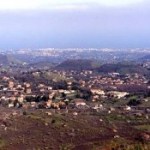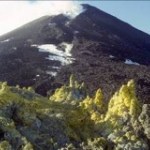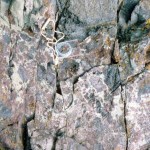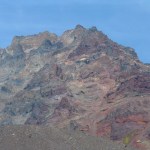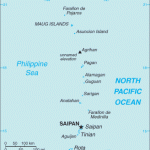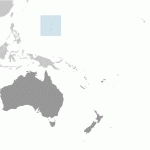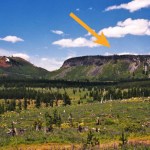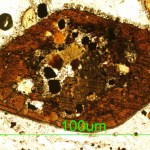Volcano Research
Sorry about the lack of posts - I've been not only frantically prepping for class and my Eyja talk, but also I'm somewhat under the weather with an ill-timed sickness, so even though there is stuff to talk about, I haven't really had time/wherewithal to deal with it.
However, expect big things from Eruptions next week!
Drawing of a ship washed inland by the tsunami generated by the August 27, 1883 eruption of Krakatau.
I'll throw a few quick links:
The alert status at Galeras has been dropped back down to "orange" after the non-explosive eruption earlier this week. However, INGEOMINAS warns…
Finally, a chance to catch up a bit ... !
Yasur erupting in May of 2010.
Some news from the world of volcanoes:
The BBC has a series of videos one the fallout from the Eyjafjallajökull eruption - including a look at the area around the volcano and how the economy has been affected by the eruption. However, things seem pretty quiet at the summit of the Eyjafjallajökull summit where snow can begun to settle without melting - and the Icelandic Met Office appears to think that the eruption is more or less (but not officially) over. And take this press release as you will, but a recent study…
The final part of Etna Week, brought to us by guest blogger Dr. Boris Behncke. Check out Part 1 and Part 2 as well!
Etna Volcanic hazards
By guest blogger Dr. Boris Behncke.
Etna is one of the most active volcanoes on Earth, and a population of nearly one million people dwell on its flanks, many in areas that have been repeatedly invaded by lava flows during the historical period. A few villages have been constructed very close to the vents of eruptions only a few hundred years old.
Top: Residential areas surrounding numerous pyroclastic cones on the lower southeast flank of Etna, seen…
This is Part 2 of 3 from guest blogger Dr. Boris Behncke. Check out Part 1 here.
The current dynamics and activity of Etna
by guest blogger Dr. Boris Behncke
The recent behavior of Etna is characterized by nearly continuous eruptive activity from the summit craters and eruptions from new vents on the flanks at intervals of a few years to decades. Summit eruptions vary from quiet lava emission to mild Strombolian explosions to high-discharge-rate Hawaiian to sub-Plinian style lava and fire fountaining accompanied by the emplacement of fast-moving lava flows; usually the strongest activity…
Italy's Mt. Etna erupting in November 2006.
Well, I am currently off in the wilderness, but that doesn't mean that things aren't still hopping here at Eruptions. We are lucky to have Dr. Boris Behncke of the INGV Catania as that blogger and he brings us a three-part series on Mt. Etna on the island of Silicy. That means this week is Etna Week here on Eruptions, so for all of you chomping at the bit for more information on the Italian volcano, you are going to get it (and then some).
modern-day satellites who can watch that same summit from space.
I think you're all going to love this series…
Earlier this summer, we had a chance to ask Sally Kuhn Sennert of the Smithsonian Institution/USGS Global Volcanism Program questions about her job as the main writer of the well-loved Weekly Volcanic Activity Report. Well, now here are the answers!
Sally Kuhn Sennert of the Global Volcanism Program in front of Mt. Rainier, Washington.
Q&A Sally Kuhn Sennert:
Q: Could you describe how you go about putting together the weekly update?
A: If time permits, I would start to gather information on Friday when particular sources post their weekly summaries. The majority of the information…
August has been rather quiet for real volcano news, but I did find some more, well, odd news to mention. It is all volcano-related - to an extent - so here we go:
The new volcano-inspired Chivas stadium in Guadalajara, Mexico.
Last year we had the volcano mall in Italy, this year we have the volcano football (that is soccer for us Americans) stadium in Mexico (see above). The stadium in Guadalajara has green, sloping sides that that open to the "crater" that is filled with the pitch and the stands - seems fitting for a city in the middle of the Trans-Mexico Volcanic Belt. No word on what…
Eyjafjallajökull erupting in the spring of 2010.
I have a request for all of you Eruptions readers! In a few weeks I will be giving a talk here at Denison on the Eyjafjallajökull eruption and especially the aspects of how the eruption unfolded on the web. I think the shared experience of the seismicity, fissure vent eruption and explosive eruption - along with all the ramifications of the air traffic stoppage over Europe - was a fascinating phenomenon. So, I ask you readers: How would you describe your experience on Eruptions during the Eyjafjallajökull events? By that I mean in terms of…
Mt. Hood in Oregon, taken August 2008. Image by Erik Klemetti. Click on the image to see a larger version.
Quick news!
I'm not going to go into too much depth right now about the recent study published in Nature Geoscience on Mt. Hood in Oregon - I plan to talk about it more in a few weeks. Why is that? Well, the lead investigator on the study, Dr. Adam Kent of Oregon State University, is a friend of mine (and occasional Eruptions commenter) so I plan to get the details from him before posting. I was also peripherally associated with some of this work - mostly in the field acting as a pack…
Mt. Elbrus in southern Russia, one of the active volcanoes in the Caucasus Mountains. (Note the prominent flow levees sticking out of the snow cover on the dacite lava flow in the middle of the image.)
Most people (including myself) aren't fully aware of the active volcanoes in the Caucasus Mountains, but sure enough, there are volcanoes that have erupted fairly recently (geologically-speaking). One of the active volcanoes in the Caucasus Mountains of Russia is Mt. Elbrus, just north of the border with Georgia, and it has erupted as recently as ~50 A.D., which for a volcano is the blink of…
Continuing my series where I try to define words of volcanic interest, the new Eruptions Word of the Day is a favorite of mine, mostly because my undergraduate thesis on Vinalhaven Island in Maine ended up dealing with a lot of these types of deposits ... so, without further ado, the word is peperite!
Now, what exactly is a "peperite"?
Well, a picture is worth 1,000 words, right (so that will save me some time):
Peperite in the Vinalhaven Diabase, Vinalhaven Island, Maine. Image by Erik Klemetti. Click on the image to see a larger version.
Let's make some observations:
The rock is full of…
Lots of little pieces of news I've run across ... time to play a little catch up.
Stromboli: A volcano after Don Ho's heart.
Every once in a while, my RSS feeds will dredge up some articles from years gone by ... and this week there were two New York Times pieces that are a few years old, but interesting nevertheless. The first is about research conducted by Dr. Robert Sohn at WHOI on explosive undersea eruptions. The second is work by Corr and Vaughan about finding subglacial volcanism in Antarctica. Both are interesting reads if you missed them (like I did) the first time around.…
The northern Chilean and southern Peruvian Andes are full of volcanoes that look stunning - I mean, jaw-dropping details of volcanism litter the landscape. The reason for this is two fold: (1) there is an awful lot of volcanism in the northern Chilean/southern Peruvian Andes (as known as the Central Volcanic Zone) - and has been that way for over 10 million years and (2) it has also been very, very dry in the area (most of which is known as the Altiplano-Puna Plateau) for at least a few millions years as well - it is the home of the Atacama Desert! So, this means you get lots of volcanic…
Our tour of the Marianas begins SW of Guam. In this area the volcanoes are submerged and make up a region known as the Southern Seamount Province. Our first stop is Tracey Seamount, which lies 30 km west of Guam. Tracey is a ~2 km tall cone and volume of ~45 km3 It is one of the smaller volcanoes in the Mariana arc; Pagan, contains about 2200 km3 of material (Bloomer et al., 1989). It has a sector collapse on its western flank and resembles a submarine Mt. St. Helens. It was investigated by the ROV Hyper-Dolphin from the R/V Natsushima in Feb. 2009, which revealed that the cone is map up of…
This week I welcome Dr. Ed Kohut as a guest blogger here on Eruptions (while I am off in the Sierras doing some field work). I've known Ed for 10 years now - we were both graduate students in igneous petrology at Oregon State University - and we are both Massachusetts natives. Ed was in the Coast Guard before getting degrees at University of Rhode Island and Boston University before heading of to Oregon State for a Ph.D., where he worked on melt inclusions in minerals. One of his major research areas is magmatism in the Mariana Islands and he was nice enough to put together a look at the…
The latest Eruptions Word of the Day is "Tuya".
So, what is a tuya?
This is a tuya:
A tuya! Click on the image to see a larger version. Image by Erik Klemetti.
Alright, well, that doesn't entirely help, does it?
Lets look at the feature the arrow indicates. Some observations:
(1) It is low and broad.
(2) It has a relatively flat top.
(3) It is steep-sided.
(4) If you look real close, you can see crudely columnar jointing in the some of the outcrops near the top.
(5) If you had a piece of it in your hand, you'd know it was a volcano rock (andesite, very rarely you can find bits that are quite…
Mineral King valley in California.
Well, we are in the peak of the summer, so Eruptions will be running a bit of summer schedule while I'm off away from the interweb tubes. First off, from July 11-20, I'll be off in the mountains, doing some much-needed fieldwork with my (first) undergraduate research student. We'll be up in the Mineral King area of Sequoia National Park looking at some old rhyolites and granites - we're talking Triassic and Jurassic submarine and subaerial calderas! We'll hopefully be taking a look at zircons in these rocks to help constrain the timescales of these…
A few very quick hits:
Ever-looming Mt. Rainier, with Tacoma, Washington in the foreground.
PHIVOLCS is pondering whether to lower the Alert Status at Taal back to Level 1. The volcano has been on Alert Level 2 for the past month after increasing signs of potential eruptive activity. However, seismicity is down at Taal, so PHIVOLCS will be sending a ground team to do a survey before deciding whether to lower the Alert Level. The heightened state of alert at Taal has lead to some people taking advantage of the populace, with little more than a fake text message to cause panic.
Just how tall…
So, I've had requests on the blog to help to do some defining of volcanologic terms on the blog, so I thought I'd try a new column called Eruptions Word of the Day. I'm not sure how often it will run, but let's give it a try.
Eruptions Word of the Day for July 5, 2010: Dacite
Dacite is a magma type defined by silica (SiO2) content between 63-68 (or 69) weight percent. That is the textbook definition, but some other typical characteristics of dacite lavas (or magmas) is the presence of certain minerals: plagioclase feldspar and hydrous minerals (containing water in their mineral structure)…
Africa is threatened by "scorching hot blobs of magma" according to the CSM.
Nothing like some fabulous headlines to make your day.
The first (courtesy of the Christian Science Monitor)
Massive blob of scorching magma discovered under southern Africa
Oh my! Yes, again, it seems that the many people in the media seem to be very confused about the nature of magma when it is underground - always expecting giant vats of swirling, molten magma rising up to destroy us all. Very few have a good sense of the real state of the Earth's mantle - mostly solid. The article is in fact about a recent study…
